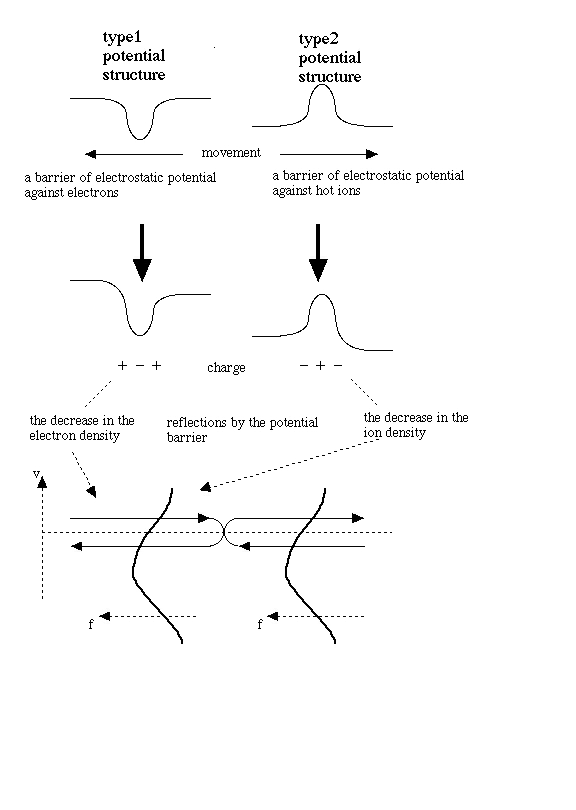Conclusions

Various types of double layers
Type 1 Weak double layer
two component model
three component model
Strong double layer resultant from type 1 weak double layer
Type 2 Weak double layer
three component model
moving solitary structure
ion hole like movement
We categorize various types of double layers into two types roughly,
a type 1 weak double layer and a type 2 weak double layer. In previous
work, double layers are divided into two types, a strong double layer
and weak double layer. But, in our work, a strong double layer is a
resultant of a weak double layer, then we do not adopt such categorization.
We performed three component simulation. In this case, most proper
classification is based on the original wave mode of weak double
layers. The type 2 weak double layer can not form in two component model.
A type 1 weak double layer and a type 2 weak double layer are formed
as a resultant of nonlinear growth of ion acoustic waves respectively,
but the two modes of ion acoustic waves are different. The one is ion
acoustic slow mode, propagating downward, the same direction of electron
flow, and the other is ion acoustic fast mode, propagating upward.
They are distinguished in the point of their original wave modes.
The type 1 weak double layer consists of three charge layers, positive-
negative-positive charge. The ion acoustic slow mode wave grows into
solitary wave with a negative potential bay, having positive-negative-
positive charge layers. But, the solitary wave has not net potential jump.
A type 1 weak double layer has field-aligned potential jump, because a spatial
structure of three charge layers is asymmetric. The negative potential bay
acts as barrier against electrons, and electrons are reflected by this potential
barrier at both sides of solitary wave. Because electrons stream downward
aligned magnetic field line faster than such solitary waves, more electrons
are reflected in the upstream region. Positive-negative-positive triple charge
layers change to positive-negative-relatively small positive charge layers
forming net potential jump consisting of a potential negative bay and a
potential jump.
Type 1 weak double layers make a movement like ion holes, which move downward
initially and are accellerated to move upward by the momentum transfer from
electrons, drawing an arc in the ion phase scape. In our model, under upward
ion beams, the movement of ion holes continue in ion beam region of phase space.
Type 2 weak double layer is characteristic of the three component model,
containing upward ion beam. It is a consequence resultant of nonlinear
growth of ion acoustic wave travelling upward, the same direction of ion beam
flow. In two component model, this mode is dumped by downward electron flow.
In this case, a solitary wave flowing upward have potential clamp which acts
potential barrier aginst upward ion beam. Ions in the upward ion beam are reflected
by this potential barrier, and more ions are reflected in downward region of the
solitary wave to configure an asymetry profile of charge density. A solitary wave has
a net potential jump and grows to a type 2 WDL. Type 2 WDL accelerate electrons downward
and ions upward.
In two component model simulation, a WDL is formed by ionospheric cold ion and magnetospheric
hot electrons. We call this classical WDL a type 1 WDL, which has net potential jump much as
hot electron thermal energy. However, in three component model, this speculation must be changed.
Single WDL has not so much potential drop as thermal energy of hot electrons, because positive charge
depletion of WDL is composed ionospheric cold ion component and the density of cold ion component is
less in three component model than in two component model. The size of potential well of WDL depends
on the density of background cold ions, and the size of potential jump of a WDL is propotional to the
size of potential well because the positive charge layers of WDL are formed by depletion of electrons
reflected by the potential well. In three component model, the interval between WDLs is not so wide
as that in two component model. Electrons are reflected by potential well specially in upward
region, and in this region, the distribution function of electrons are modificated. In this electron
excess region ,which enlarges spatially during formation of potential well, an additional WDL cannot be
formed, because this excess of electron prohibit a formation of electron deflection region. In three
component model, the depth of a potential well is nearly propotional to the density of cold ion.
A large potetial well can trap fast electrons, and the large electron deflection region is formed.
As a result, the interval between WDLs are small in three component model. Sato and Okuda[1981] shows
an interval of WDLs is about 1000 Debye length. In this case, the size of potential well is nearly an
electron thermal energy, and an potential drop can trap electrons whose velocity is electron thermal velocity.
These electrons can run hundreds of Debye length during an WDL formation.
